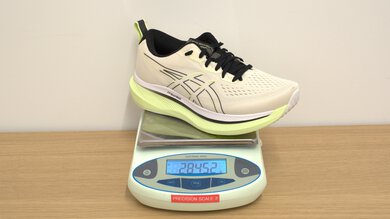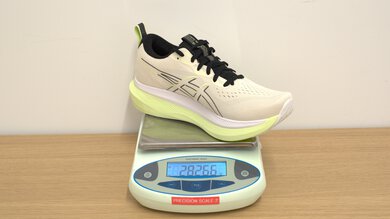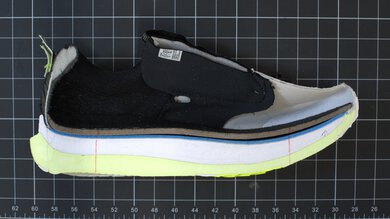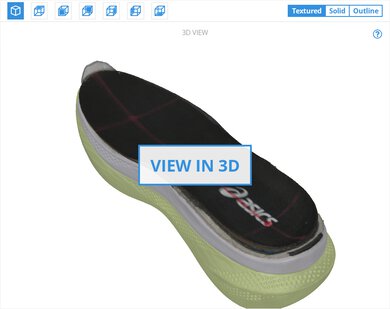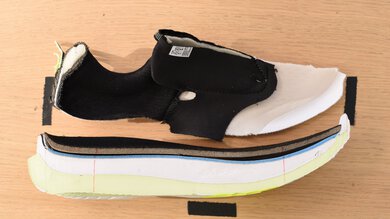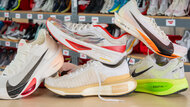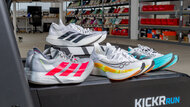The ASICS GLIDERIDE MAX is a cushioned daily trainer designed for maximum comfort during longer-distance efforts. With a very high stack and a moderately pronounced rocker for smoother transitions, it offers a good balance of cushioning and efficiency for its class. For added stability, it's also fitted with a 3/4 EVA plate in the mid and forefoot that's sandwiched between layers of FF BLAST MAX and FF BLAST PLUS ECO foams.
Our Verdict
The ASICS GLIDERIDE MAX is inadequate for marathon racing. It isn't ideal for faster efforts, with limited energy return and a heavier weight that can get cumbersome over the full distance of a marathon. However, its cushioned midsole and structural elements, like an EVA plate and pronounced rocker, make it a bit more dynamic than other shoes in its category.
-
Dual-layer midsole foam provides good cushioning.
-
Feels relatively stable.
-
Limited energy return.
-
Fairly heavy.
The ASICS GLIDERIDE MAX is sub-par for 5K/10K racing. It's mainly designed for longer distances and slower paces, with a max-cushioned design and relatively heavy weight that makes it inefficient for racing. While its rockered geometry and firm forefoot make for smooth transitions, it lacks the energy return needed for up-tempo efforts.
-
3/4-length EVA plate adds rigidity in the forefoot.
-
Limited energy return.
-
Fairly heavy.
The ASICS GLIDERIDE MAX delivers poor energy return. The energy loss in both the heel and forefoot makes it less suited to fast-paced runs.
-
Limited energy return.
The ASICS GLIDERIDE MAX is well-cushioned. It offers a good amount of protection underfoot, which is especially important for reducing fatigue at longer distances.
-
Dual-layer midsole foam provides good cushioning.
The ASICS GLIDERIDE MAX has good lateral stability. Its fully gusseted tongue and relatively wide outsole create a stable platform with good lockdown. The combination of different foams, with an EVA plate in between for a bit more rigidity, also makes for a relatively firm and controlled forefoot. That said, the heel is notably softer and, therefore, less stable, and the shoe's towering stack height gives a sensation of being lifted off the ground.
-
Wide outsole.
-
3/4-length EVA plate adds rigidity in the forefoot.
-
Fully gusseted tongue for better lockdown.
-
Very high stack height.
-
Foam at the heel is quite soft.
- 5.1 Marathon Racing
- 5.9 5K/10K Racing
Performance Usages
- 2.6 Energy Return
- 7.7 Cushioning
- 7.8 Lateral Stability
Changelog
- Updated Apr 02, 2025: Converted to Test Bench 0.8.
- Updated Apr 02, 2025: Review published.
Check Price
Differences Between Sizes And Variants
We purchased and tested the ASICS GLIDERIDE MAX in men's US size 9 in the Birch/Black colorway. Here's the label for our pair. Depending on the region, the shoe also comes in a range of other colorways, including Black/Oatmeal, Soothing Sea/Wave Teal, and Digital Aqua/New Leaf, with additional colorways like Black/Pale Pink and Bold Magenta/Soothing Sea in women's sizing.
The shoe is available in standard and wide widths.
Compared To Other Running Shoes
The ASICS GLIDERIDE MAX is a max-cushioned daily trainer built for casual paces. As a higher-stack revitalization of the previously discontinued ASICS GLIDERIDE series, the GLIDERIDE MAX occupies a liminal space in the ASICS lineup, with some high-tech features like a hybrid foam midsole, pronounced rocker, and 3/4 plastic plate that make it stand out as a daily trainer. However, it lacks the agility and versatility of models like the ASICS NOVABLAST 4 and ASICS SUPERBLAST 2 while also sitting at a higher price point than the mainstay ASICS GEL-NIMBUS 26, which offers a similarly cushioned ride. Still, if you want to add a maximalist trainer with a smooth, well-cushioned ride to your rotation, you could do worse.
See our recommendations for the best running shoes we've tested for other options.
The ASICS NOVABLAST 5 is better overall than the ASICS GLIDERIDE MAX, but each shoe has its strong suit. The NOVABLAST 5 is better for picking up the pace, with significantly better energy return and a more lightweight design. The GLIDERIDE MAX, by contrast, is a much more stable shoe that's better suited for longer, easier miles.
The ASICS SUPERBLAST 2 is better overall than the ASICS GLIDERIDE MAX, though it's also a more premium trainer. Its PEBA-based hybrid foam significantly improves its energy return while maintaining good cushioning for longer runs.
The ASICS GLIDERIDE MAX is like a slightly more elevated (literally and figuratively) ASICS GEL-NIMBUS 26. While both are designed with high-stack, max comfort in mind, the GLIDERIDE MAX is a bit lighter and has some added features, like a rocker and a partial EVA plate, that give it a slightly smoother ride. It's also got a more premium foam which is softer in the heel.
The ASICS GLIDERIDE MAX and the Brooks Glycerin Max are both highly cushioned daily trainers that perform very similarly overall. They both provide sufficient cushioning and return similar energy, though the ASICS is a bit lighter and more stable.
The ASICS NOVABLAST 4 is a bit more versatile than the ASICS GLIDERIDE MAX. It's lighter and offers better energy return, making for a bouncier ride for tempo work and faster paces. However, the GLIDERIDE MAX is a better fit for longer distances, offering a more stable, cushioned ride.
Test Results
The shoe is on the heavier side, especially compared to more agile trainers like the ASICS NOVABLAST 4, but it's far from the heaviest shoe in its class.
For added stability, the ASICS GLIDERIDE MAX includes an EVA plastic plate that sits in between the white FF BLAST MAX foam and the green FF BLAST+ ECO foam on the bottom. However, it only covers about three quarters of the shoe's length, mostly in the midfoot and forefoot.
The heel doesn't return a lot of energy, so the shoe doesn't feel as bouncy or responsive as more performance-oriented models.
The forefoot returns more energy than the heel, giving you a bit more propulsion when toeing off, but it still lacks sufficient rebound for a responsive ride at faster paces.
Overall, the cushioning at the heel is good, especially at higher forces. It's well-suited for heel strikers who want a bit more protection underfoot for easy miles and longer distances.
The forefoot is also well-cushioned, though marginally less so than the heel. There's less compression in the forefoot, but it still has good impact absorption overall.
The foam in the heel is on the softer side. Heel strikers especially will find it less rigid, which makes it more forgiving when form deteriorates near the end of a long run.
The shoe's forefoot is significantly more firm than the heel, providing a bit more stability when transitioning from heel to toe. The EVA plate adds some rigidity in the forefoot but not as much as carbon-plated racers like the Saucony Endorphin Pro 4.
Check Price
Comments
ASICS GLIDERIDE MAX: Main Discussion
Let us know why you want us to review the product here, or encourage others to vote for this product.
We’ve just released a new video that mentions the Acer Nitro XV275K P3biipruzx, AOC Q27G3XMN, ASUS ROG Strix OLED XG27ACDNG, and ASUS ROG Swift OLED PG27UCDM here.


